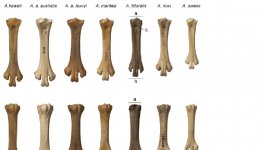Fred Ruhe
Well-known member

Alan James Drummond Tennyson & Barbara Mizuma Tomotani, 2021
A new fossil species of kiwi (Aves: Apterygidae) from the mid-Pleistocene of New Zealand
Historical Biology: An International Journal of Paleobiology. in press.
doi:10.1080/08912963.2021.1916011
Abstract: https://www.tandfonline.com/doi/full/10.1080/08912963.2021.1916011?src=
We describe Apteryx littoralis sp. nov., a new species of kiwi based on a 1-million-year-old tarsometatarsus from shallow marine sediment in the North Island of New Zealand. The fossil is very similar to the tarsometatarsi of living kiwi species, most closely resembling Apteryx rowi and A. mantelli in size and shape, but differs in being stouter, with proportionally narrower proximal and distal ends. The new fossil is the second oldest known record of kiwi. It demonstrates a relatively conservative kiwi morphology since the mid-Pleistocene.
Enjoy,
Fred
A new fossil species of kiwi (Aves: Apterygidae) from the mid-Pleistocene of New Zealand
Historical Biology: An International Journal of Paleobiology. in press.
doi:10.1080/08912963.2021.1916011
Abstract: https://www.tandfonline.com/doi/full/10.1080/08912963.2021.1916011?src=
We describe Apteryx littoralis sp. nov., a new species of kiwi based on a 1-million-year-old tarsometatarsus from shallow marine sediment in the North Island of New Zealand. The fossil is very similar to the tarsometatarsi of living kiwi species, most closely resembling Apteryx rowi and A. mantelli in size and shape, but differs in being stouter, with proportionally narrower proximal and distal ends. The new fossil is the second oldest known record of kiwi. It demonstrates a relatively conservative kiwi morphology since the mid-Pleistocene.
Enjoy,
Fred
Last edited:




